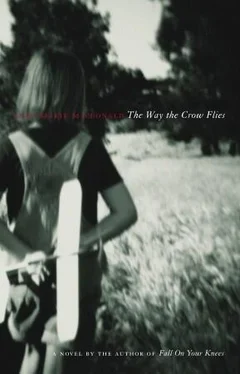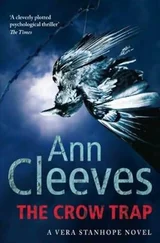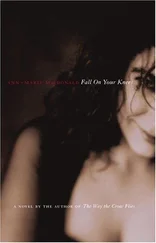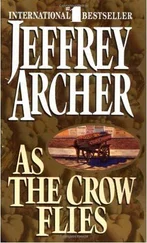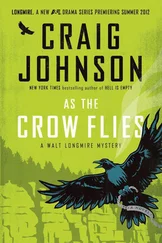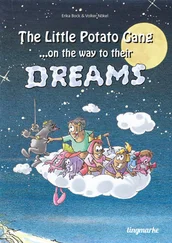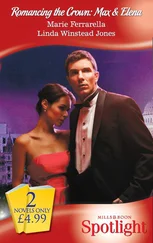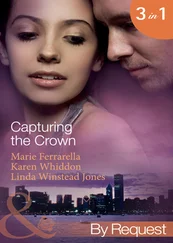Comedy. The brain surgery of the performing arts.
They went out, just the two of them, for dinner at a Swiss Chalet. He spread out a paper napkin. “What business are you in?”
“The funny business.”
“What are you selling?”
“Laughs.”
“No. You’re selling stories. Every joke tells a story. Every laugh is the result of a combination of surprise and recognition—” he wrote the two words down on the napkin, then enclosed them in boxes each with an arrow pointing to the blank middle of the napkin. “The unexpected and the inevitable”—two more boxes—“that’s what stories are made of, whether they’re happy or sad—” two circles, one smiling, one frowning, separated by a slash, connected to the blank centre by a wavy line. “It’s no good just making fun of things, even though it’s important to have all that mimetic talent and wit”—two more circles—“you have to have a point of view”—overarching heading—“and that’s what you’ve got.” He tossed the pen to the table. “A little different way of seeing the world. And the ability to let other people see it that way too. You take the familiar and tilt it. The ability to see things from multiple simultaneous points of view is a sign of genius.”
He had left the centre of the napkin blank, so she filled it in — STORY — and drew a circle around it.
He grinned. “That’s right. There’s your feedback loop.”
She looked at the mini-solar system. “It’s like a consolation,” she said.
He nodded. They had both heard her say “constellation.”
In those days, Toronto was a hair shirt, despite the best efforts of Yorkville with its coffee houses, its folk singers, and radicals; still Toronto the Good, WASP bastion. This was before pad thai, before spritzers and “Beemers,” when “pasta” was still spaghetti, before anyone “did” lunch, and when career women wore chiffon scarves with their pantsuits. But she found an apartment on Queen West, over a textile store run by an unsmiling Hungarian couple, and stumbled upon a rich vein of counterculture. A bar called the Cameron was a hothouse of art, music and theatre, a multimedia mecca where hipsters of all races drank side by side with honest-to-goodness Sally Ann hobos. She had a brief but pivotal affair with an intense alcoholic feminist, the publisher of an underground Marxist-Leninist newspaper, whose phone was tapped by the RCMP — it would have reflected badly on her if it hadn’t been.
She performed wherever she could, developing the gourd-like rind that every comic needs, and that a woman couldn’t live without if she was crazy enough to do stand-up. Phyllis Diller stood at the edge of the known world; beyond her were sea monsters. The new generation of brilliant funny women worked mainly in ensembles or in story-based one-woman-show contexts. Gilda Radner, Lily Tomlin, Andrea Martin, Jane Curtin…. There was safety in numbers, whereas stand-up was strictly kill or be killed.
How’d it go tonight?
I killed/I died .
In the clubs, comics were like indentured servants, clawing their way onto the stage in exchange for a kidney, their first-born child, their left testicle, but the women comics — wait a second, women comics? At Yuk Yuk’s, the hook was used liberally and literally. The safest stuff was “blue,” mean and macho, but Madeleine couldn’t have pulled that off if she’d tried.
What business are you in?
The funny business .
What are you selling?
Stories .
She died at Yuk Yuk’s, then auditioned at the Old Fire Hall for the Second City touring company. She hit the road, and often the Fire Hall stage itself, when the main company took a night off. It was almost as rare to cross over from stand-up to improv as it was to be a female stand-up in the first place. But she loved having a gang, she gloried in high-speed improvisation, doing sketches that were “about something”—politics, pop culture, the hostile grocery clerk this morning, processing whatever had happened in her day, working it all out at night on stage. In between sketches, ransacking the flea-bitten costume pile backstage; the exultation that accompanied the appearance of a new character courtesy of that red shirt, that hat, those boots, without which you would never be able to do that character again—“where th e fuck is that red shirt?!” The bizarre and strangely ritualized behaviour that preceded every performance, jokes among themselves so gross they’d have had to import earth-moving equipment to go any lower. Big huge Tony prancing nearly nude through the dressing rooms like a Las Vegas showgirl, seizing and humping the company dry-cleaning with great graphic gusto when it arrived, then hitting the stage with a wholesome smile, ready to entertain the Rotary Club. They toured relentlessly, Welcome to Kingston, Gananoque, Chatham, Hamilton, Windsor, Sudbury, North Bay, Timmins . They played roller rinks where punchlines took ten seconds to hit the back of the arena. They did benefits — once for a Holocaust museum where the emcee brought out a child’s shoe from Auschwitz before introducing them, “Now here to entertain us …”
She bought a vintage VW bug and retraced the tour on her own, doing stand-up in every burg with a university or bar. Alone, alone, all, all alone. Alone on a wide wide sea . She did the club-sandwich circuit and graduated from seedy motels to Holiday Inns. She honed her craft before rooms where half the tables were empty and the other half full of lonely guys waiting for the stripper to come on. She survived a stag party of drunken engineers who tossed a blow-up doll around the room throughout her act—“isn’t it a shame when cousins marry?” She performed for musty nickel miners and their dates, who had turned out in the misprinted expectation of singing along with Stompin’ Tom Connors. She learned to love the beehived silhouettes that came to pack her return gigs in the taverns and “cabana rooms” of borscht-belt north. Make the women laugh, put the guys at ease, then turn up the heat until, by the end, she had come out as a burly nickel miner trapped in the body of a muff-diving lezzie. It helped that she was cute.
It was after Stonewall but before “gay pride.” If she wasn’t murdered in the parking lot, she would be taken into countless gnarly normal hearts. It helped that she met Christine — a Women’s Studies major whose father was a cop in Timmins. Madeleine didn’t have to explain contradiction to her. Christine wore batik dresses with police boots, kept her hair long and drove standard. She regularly rescued Madeleine, turning up in Sarnia with a cooler full of pesto and wine, a pillow from home, and a willingness to have sex that involved nothing but sleep afterwards.
She quit the touring company before she could be fired or promoted, and focused on in-town. Christine told her what to read and Madeleine sharpened her mental knives late-nights in Toronto at a boozecan-cum-salon called Rear Window. She started out as The Astonishing Elastowoman. She branched out with The Astonishing Elastowoman’s Introduction to Classics of Western Civilization. She branched and branched and branched. She became known for her bendy body and bizarre male characters, including Anita Bryant. There was Lou, a powder-blue-polyester-leisure-suited lounge lizard who accompanied himself on accordion and sang with an outrageous French accent. There was Roger of Roger’s Room, a fifteen-year-old boy obsessed with Soldier of Fortune magazine, prone to tears and fond of his pet turtle. At the end of every sketch, he would look down the sights of an AK-47 and name all the people he saw there the way the chick on Romper Room used to do with her magic mirror. And there was Maurice.
Читать дальше
